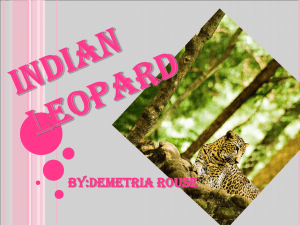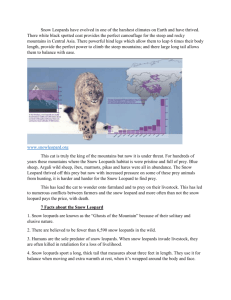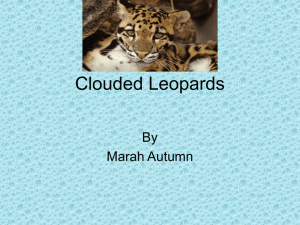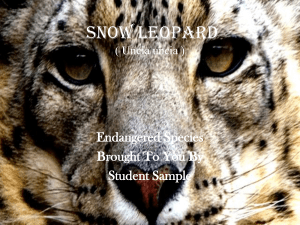File - Marissa Weissner
advertisement
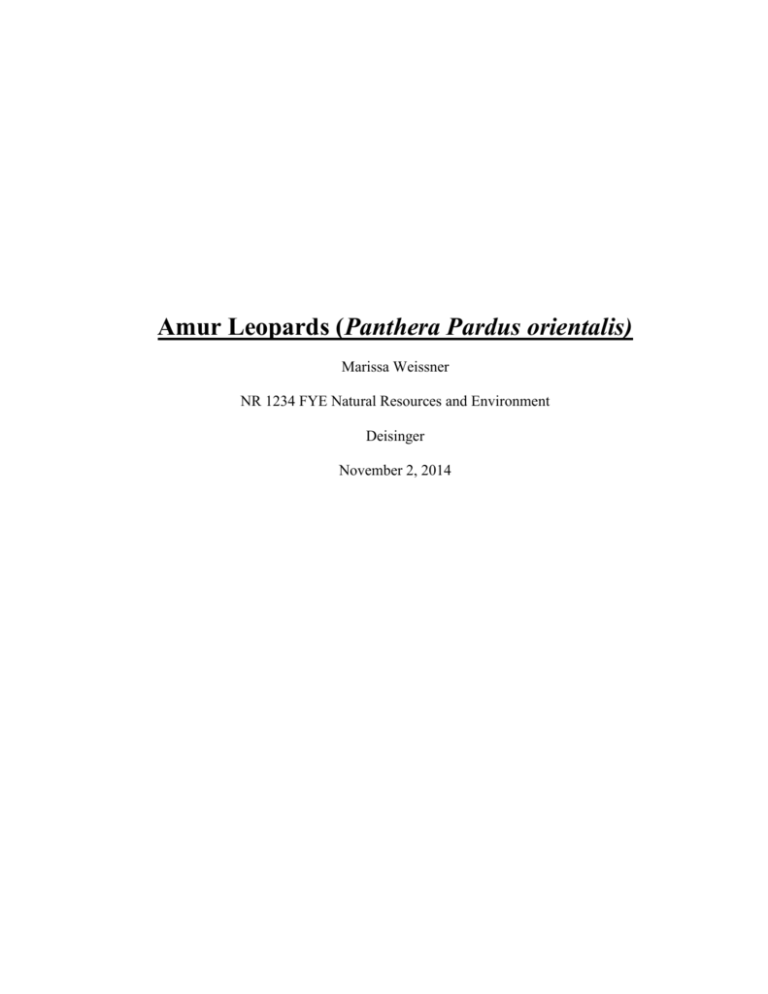
Amur Leopards (Panthera Pardus orientalis) Marissa Weissner NR 1234 FYE Natural Resources and Environment Deisinger November 2, 2014 Amur Leopards, scientifically named Panthera Pardus orientalis, are characterized as critically endangered by the World Wildlife Fund. They became categorized as critically endangered in 1996 (Jackson P). They are also considered the “world’s most endangered large felid subspecies” (Hebblewhite). The leopards tend to live in the mountains and temperate, broadleaf, and mixed forests in the Russian Far East and North East China. (World Wildlife Fund). In the wild, there are approximately 30 individuals left (Jackson). There are many impacts that are inhibiting the Amur Leopard population and habitat. These impacts can be broken down into human impacts and natural impacts (see figure 1). Human impacts resulting in the decline of the Amur Leopards are deforestation, prey scarcity, illegal trade and poaching, and development projects in their habitat. While human impacts cause a lot of damage to the population, there are natural effects that are also causing the population to decline and there are; inbreeding, loss of genetic diversity, and also prey scarcity. There are many tactics that are being done to restore the Amur Leopards habitat and population; such as monitoring the population, stopping poaching and trading, creating safe havens to protect the habitats, minimizing inbreeding, conserving their genetic makeup and analyzing their genetic makeup. With these measure being done now, there are now approximately 200 captive Amur Leopards in zoos and around the world (Yang). The decline of the population can be broken into two groups; human impacts and natural impacts where natural impacts are caused by human impacts. Deforestation is a major factor in the declination of the Amur Leopard population because it reduces the leopard’s habitat causing them to be unable to find food or shelter as easily. Deforestation also causes development projects where farmers take over the deforested land and begin to hunt the same prey as the leopards causing prey scarcity (Matteson). Both deforestation and development projects pushes the leopards out of their habitat and cause prey scarcity. Prey scarcity is also a major factor in the declination of the population since there are not enough prey to sustain large population of both the leopards and tigers in the habitat (World Wildlife Fund). In order for the Amur Leopard population to increase and reclaim its range, then the prey populations need to increase as well. This is the only factor that is both caused by humans and by nature. The last human impact is the illegal wildlife trading and poaching of many Amur Leopards. The most common reason of poaching is for their spotted fur, which also causes prey scarcity because the poachers also poach the prey as well as the leopards (Holmberg). Illegal trading and poaching not only affects the Amur Leopards but also the prey and the ecosystem as a whole. The natural impacts on the declination of the Amur Leopards are mostly caused by the human impacts. Inbreeding is becoming a large problem because as the population decreases there is more probability that the leopards are breeding within their family, with their mother, father, or siblings (Uphyrkina 2002). With an increase in inbreeding, the populations genetic makeup degenerates and the population can begin to have diseases and other harmful impacts to their health or behavior. Genetic degeneration, or the loss of genetic diversity, is a huge problem because with inbreeding rates increasing the more the DNA gets mixed up and can cause fatal diseases. The main impact of genetic degeneration is from inbreeding, due to small population sizes (Uphyrkina 2003).With an increase in the captive population, there is hope for an increase in the genetic diversity in Amur Leopards (Uphyrkina 2003). So far, there are a lot of methods on saving the Amur Leopards from extinction. Many people and organizations are trying to stop poaching and trading, monitoring the populations in the wild, creating safe havens and protecting their habitats, and minimizing inbreeding with zoos. The World Wildlife Fund is working with TRAFFIC, trade monitoring network, to enforce trade restrictions and are also listed on CITIES Appendix I, which prohibits all commercial trade (World Wildlife Fund). They are also using camera traps to monitor their populations and its habitat as well as trying to increase the prey population (World Wildlife Fund). There are also new national parks opening up to protect the Amur Leopards as well as the prey and habitat and the Wildlife Conservation Society also works in protecting their habitat, monitoring the populations of all the animals in that habitat, and conducting law enforcement on poaching and trading (Wildlife Conservation Society). Zoos are an important part to increasing the population of Amur Leopards by limiting inbreeding as well as getting the Leopards ready to be reintroduced to their original habitat. Zoos provide suitable breeding patterns between Leopards as well as providing funds for the restoration project (Kelly). Zoos also provide the public with knowledge about their habitats, critical status, and other fun and interesting facts (Kelly). Zoos also provide a safe haven for the Leopards as their habitats are trying to be conserved. The pros to helping the Amur Leopards is that they are “important ecologically, economically, and culturally” to their ecosystem and benefit the other species found in the same habitat (World Wildlife Fund). Without the Amur Leopards and the conservation efforts, the ecosystem within their habitat would begin to deteriorate as other predators and prey began to decline in population. The cons to helping the Amur Leopards would be the cost to saving their habitat, stopping poaching, and other conservation efforts. A lot of money is needed for the reintroduction program run by zoos and the analysis of their genetic makeup. Amur Leopards are categorized as critically endangered and are affected both by humans as well as nature. There are many conservation tactics set up to improve the population of both the Amur Leopards and their prey. With the conservation efforts of helping the Amur Leopards we are also helping the Amur Tigers in the habitat as well as the prey species, like deer. With the right conservation, hard work, and funding from many different program we will be able to increase the population as well as ensure long-term conservation of their habitat and population. The Amur Leopards have a large impact on their habitat and if they continue to decline, the ecosystem and habitat will be greatly affected and the other animals will also begin to decline. Literature Citations (see figure 2) Hebblewhite M, Miquelle D, Murzin A, Aramilev V, Pikunov D (2011) Predicting potential habitat and population size for reintroduction of the Far Eastern leopards in the Russian Far East Biol Conserv 144: 2403-2413. doi:10.1016/j.biocon.2011.03.020 Holmberg L (2014) Help! Save the Amur Leopard from extinction. Change.org Inc. http://www.change.org/p/help-save-the-amur-leopard-from-extinction. Accessed 27 September 2014 Jackson P, Nowell K (2008) Panthera pardus ssp. orientalis The IUCN Red List of threatened species http://www.iucnredlist.org/details/15957/0. Accessed 29 September 2014 Kelly P, Stack D, Harley J (2013) A review of the proposed reintroduction program for the Far Eastern Leopard (Panthera pardus orientalis) and the role of conservation organizations, veterinarians, and zoos. Compan An Med 28: 163-166 Matteson C (2014) Animals and Deforestation. New York, New York, pp 23-25 Uphyrkina O, Miquelle D, Quigley H, Driscoll C, O’Brian S J (2002) Conservation genetics of the Far Eastern Leopard (Panthera pardus orientalis). J Hered 93: 303-311 Uphyrkina O, O’Brien S (2003) Applying molecular genetic tools to the conservation and action plan for the critically endangered Far Eastern leopard (Panthera pardus orientalis) C R Biologies 326: S93-S97. doi:10.1016/S1631-0691(03)00044-1 Wildlife Conservation Society (2013) Land of the Leopard opens in Russia. Wildlife Conservation Society. http://www.wcs.org/news-and-features-main/land-of-the-leopard -national-park.aspx. Accessed 26 September 2014 World Wildlife Fund (2014) Amur Leopard. World Wildlife Fund. https://www.worldwildlife.org/species/amur-leopard. Accessed 26 September 2014 Yang, Yi (2013) New home for Amur Leopards at Staten Island Zoo. New York, New York Figures Figure 1: Concept Map. This breaks down the problem statement into different main ideas and supporting details. The white bubble is the problem statement, the blue bubbles are the main ideas and the green bubbles are the supporting details. Problem Statement Amur Leopards are found primarily in the mountains and forests of Amur-Heilong, in North East China and Russia Far East, and are categorized as critically endangered. How have the Amur Leopards become critically endangered and what can we do to help them reestablish their populations? Five Axioms of Sustainability The first axiom: Any society that continues to use critical resources unsustainably will collapse is the most relevant. Table of Essential ideas/concepts Primary Concept Amur Leopard Concept Categories Synonyms Panthera pardus orientalis Far Eastern Leopard Secondary Concepts 1 2 3 Human Impacts Inbreeding/ Prey Scarcity Conservation Poaching Genetic degeneration Protection Forest degradation Development projects Loss of genetic diversity Management Reintroduction Search statements and search databases a. First Search statement: (“Amur Leopard” OR “Far Eastern Leopard”) AND (Management AND Conservation) b. Second Search statement: (“Amur Leopard” OR “Panthera pardus orientalis”) AND (poaching AND deforestation) c. Third Search statement: (“Amur Leopard” OR “Far Eastern Leopard”) AND (Inbreeding AND “Prey Scarcity”) d. Fourth Search statement: (“Amur Leopard” OR “Far Eastern Leopard”)AND (poaching OR deforestation) Search Database/index statement used to search (a,b,c) (e.g. Summon, Cab Abstracts, etc) A Summons Number of results retrieved Notes about search results (e.g. too many, too few, many seem relevant/irrelevant, new terms to try in searches, etc) Number of items save to a folder 212 Many of the articles are relevant, but there are too many options. A new key term I could use is reintroduction. Many of the articles were irrelevant but there was an overview article. Many of the articles were related but most of them were not useful. Found an overview from the WWF on the critically endangered Amur Leopards. A few of the articles were useful but there were too few results that I could actually use Very few articles were helpful but most of them were relevant. 3 B Summons 44 A Google Scholar 345 Amur Leopard Google 390,000 C Ebsco Host: Academic Search Complete Google Scholar 363 D 224 1 2 1 1 2 Sources 1. Wildlife Conservation Society (2013) Land of the Leopard Opens in Russia. Wildlife Conservation Society. http://www.wcs.org/news-and-features-main/land-of-the-leopard -national-park.aspx. Accessed 26 September 2014 This is a very interesting article and has some information on how we are helping the Amur Leopards out of extinction. There is now a new national park in Russia for the critically endangered Amur Leopards. This article is very useful with information on the new national park. 2. World Wildlife Fund (2014) Amur Leopard. World Wildlife Fund. https://www.worldwildlife.org/species/amur-leopard. Accessed 26 September 2014 This gives an overview of the Amur Leopards “lifestyle”, why they are important to their ecosystem, the threats that they are dealing with, and what is currently being done to help them repopulate. This is useful because it gives easy to read information on both the threats and what is being done. 3. Holmberg L (2014) Help! Save the Amur Leopard from extinction. Change.org Inc. http://www.change.org/p/help-save-the-amur-leopard-from-extinction. Accessed 27 September 2014 This gives a short and sweet description of what is happening to the Amur Leopards and what we can do to try to save them. It even gives a statistic stating that Amur leopards lost 80% of its habitat in 13 years. It even has a copy of a petition sent to Vladimir Putin to help the Amur Leopards. 4. Matteson C (2014) Animals and Deforestation. New York, New York, pp 23-25 This book gives a description of the Amur Leopards; like their size weight, speed, how high they can leap, and their distinct pattern of fur. It gives a description of their habitat and what has a major impact on their population and habitat. 5. Uphyrkina O, Miquelle D, Quigley H, Driscoll C, O’Brian S J (2002) Conservation Genetics of the Far Eastern Leopard (Panthera pardus orientalis). J Hered 93: 303-311 This is an interesting journal article on the Amur Leopards and how to conserve their genetic makeup and their population. Unfortunately there are only between 25-40 individuals alive. This article is relevant to my study. It also talks about immigration from captive populations. 6. Kelly P, Stack D, Harley J (2013) A Review of the Proposed Reintroduction Program for the Far Eastern Leopard (Panthera pardus orientalis) and the Role of Conservation Organizations, Veterinarians, and Zoos. Compan An Med 28: 163-166 This journal article gives an overview of reintroduction programs with zoos. Zoos are a key component to reintroducing a species to help breed them and to reintroduce them as well as educating the public. It also gives an overview of the domino effect of the loss of the Amur Leopards and its effect on the ecosystem. 7. Hebblewhite M, Miquelle D, Murzin A, Aramilev V, Pikunov D (2011) Predicting potential habitat and population size for reintroduction of the Far Eastern leopards in the Russian Far East Biol Conserv 144: 2403-2413. doi:10.1016/j.biocon.2011.03.020 This is a very interesting journal article, which talks about which population size would be acceptable to reintroduce the Amur Leopards into Russian Far East and how to get to that population size. It also describes the habitats that the Amur Leopards were found using their tracks. 8. Yang, Yi (2013) New Home for Amur Leopards at Staten Island Zoo. New York, New York This newspaper article is an overview of how three Amur Leopards were moved to the Staten Island Zoo and how it is a part of the Species Survival Program. The zoo also pays close attention to breeding so to keep inbreeding to a minimum. This article also describes a few threats that are threatening the Amur Leopard’s population in the wild. 9. Uphyrkina O, O’Brien S (2003) Applying molecular genetic tools to the conservation and action plan for the critically endangered Far Eastern leopard (Panthera pardus orientalis) C R Biologies 326: S93-S97. doi:10.1016/S1631-0691(03)00044-1 This journal article talks about the role of molecular genetics in helping with endangered species. Molecular genetics provides insight into the specie’s history and current health and can help reintroduce the species and increase their population. The genetic analysis can help advance strategies to increase the Amur Leopard population. 10. Jackson P, Nowell K (2008) Panthera pardus ssp. orientalis The IUCN Red List of Threatened Species http://www.iucnredlist.org/details/15957/0. Accessed 29 September 2014 This gives a short and sweet overview of the Amur Leopard’s taxonomy, history, assessment, geographic range, population, and habitat and ecology in an easy to read format. It even gives other links to find more information and images of the Amur Leopard. This is an easy to use site for finding quick information and external links. Figure 2: Literature Review. This contains the problem statement, axiom of sustainability, essential ideas and concepts used to search for information, search statements which helped locate useful documents, and an overview of each of the sources.
